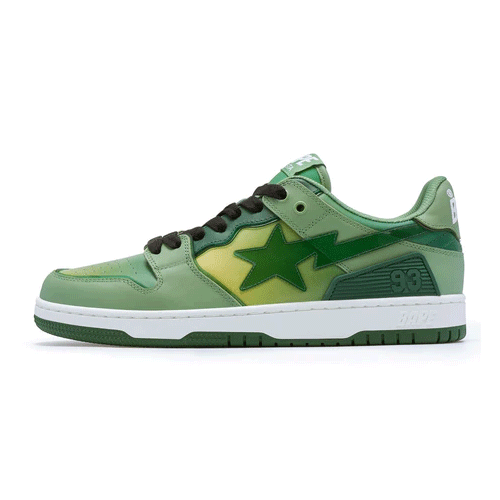Articles
The Rise and Reign of Bapesta: Streetwear’s Iconic Sneaker Statement

Share article
In the ever-evolving world of sneakers and streetwear, few silhouettes hold as much cultural cachet as the Bapesta. Originally introduced by Japanese streetwear brand A Bathing Ape (BAPE) in the early 2000s, the Bapesta quickly became a bold, rebellious symbol of fashion counterculture. Its shiny patent leather, vibrant colors, and unmistakable lightning bolt logo made it an instant icon—often drawing comparisons to the Nike Air Force 1, but with a distinctly louder, more expressive twist.
Today, Bapesta stands not just as a sneaker, but as a statement—a declaration of individuality, creativity, and an unshakable connection to hip-hop and global youth culture.
The Origin Story of Bapesta: From Harajuku to the World Bapesta was first released in 2002 by Nigo, the founder of BAPE. Inspired by American hip-hop culture and sneaker obsession, Nigo designed the Bapesta as a Japanese response to the classic basketball shoes dominating the U.S. market. While it clearly borrowed elements from Nike’s Air Force 1 in terms of silhouette, the Bapesta distinguished itself with wild colorways, bold graphics, and materials that turned heads.
Its design choices weren’t coincidental. The early 2000s marked a time when fashion began to merge more directly with music, particularly hip-hop. Artists like Pharrell Williams, Kanye West, and Lil Wayne proudly rocked Bapestas in music videos and public appearances, giving the shoe global recognition.
Bapesta vs. Air Force 1: Homage or Hype?
No conversation about Bapesta is complete without mentioning its resemblance to the Nike Air Force 1. From the outsole to the overall silhouette, the similarities are undeniable. However, what sets the Bapesta apart is how it reimagines a familiar form into something unmistakably unique.
Instead of the Nike Swoosh, Bapesta features the "STA" lightning bolt, and its colorways often lean into high-gloss patent finishes, neon tones, and even camo prints—something Nike rarely explored at the time. In many ways, Bapesta was ahead of its time, foreshadowing the customization and wild color trends we now see in sneaker culture.
Despite the similarities, Bapesta gained a cult following, not just as a lookalike, but as a standalone symbol of creative rebellion. It was embraced not because it mimicked the Air Force 1, but because it remixed it with fearless authenticity.
The Cultural Impact: Music, Hype, and Legacy
The BAPE Shoes became more than just a sneaker—it became a cultural artifact. When hip-hop artists started wearing Bapesta, they weren’t just making fashion statements; they were showcasing their alignment with streetwear subculture and an appreciation for Japanese fashion’s unique lens.
Artists like Soulja Boy wore Bapestas in music videos, while Pharrell and Nigo’s friendship led to legendary collaborations through their Billionaire Boys Club and Ice Cream brands. Bapesta became the go-to sneaker for those who were “in the know”—those who understood fashion was as much about community as it was about clothes.
Final Thoughts: Bapesta’s Timeless Appeal
In a world where sneaker trends shift quickly, the Bapesta has proven its staying power. What started as a bold reinterpretation of an American classic has become a global fashion icon, fusing Tokyo streetwear with hip-hop swagger and an endless appetite for self-expression.
Advertisement

